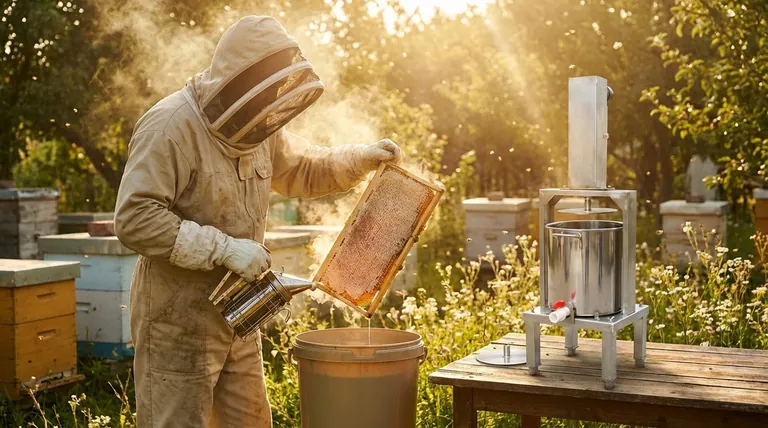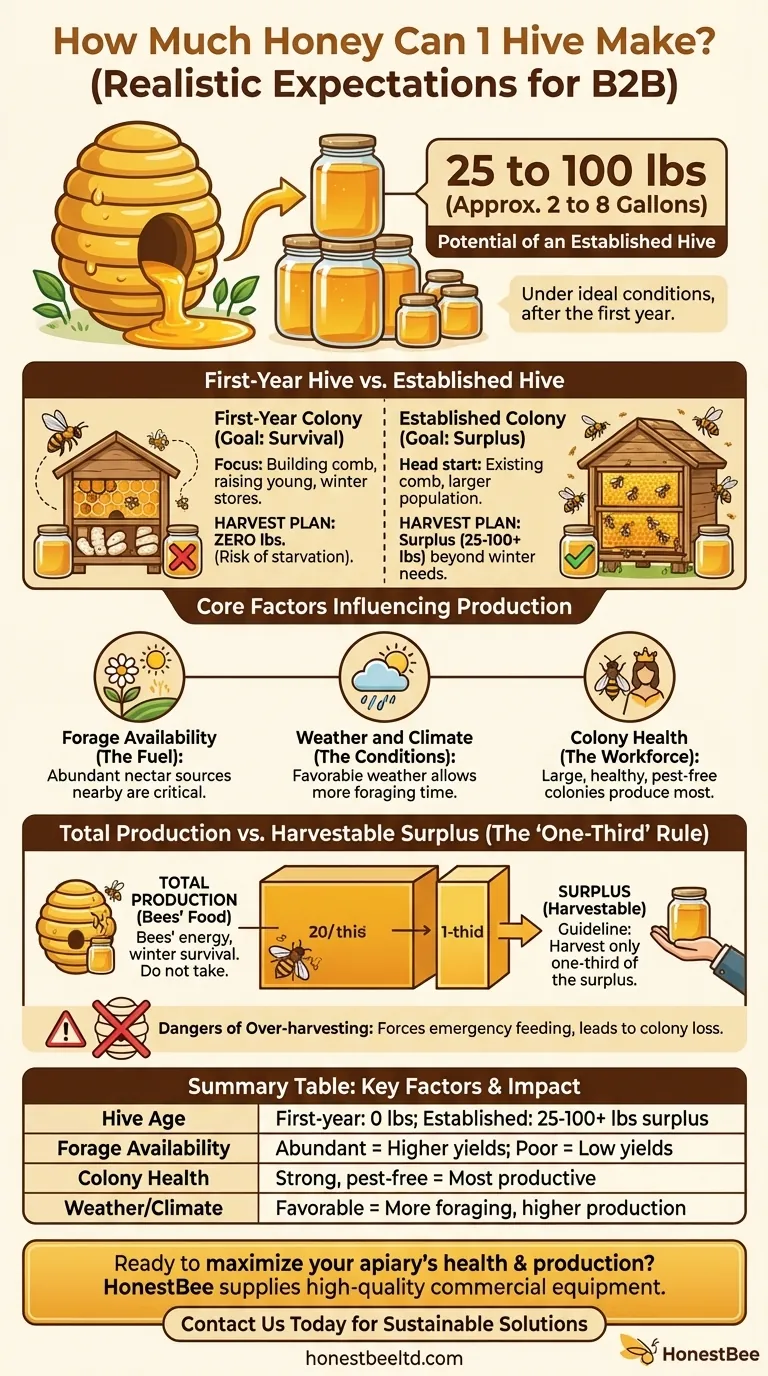Under ideal conditions, a single, established bee hive can produce a significant amount of honey. You can realistically expect to harvest anywhere from 25 to 100 pounds (approximately 2 to 8 gallons) from a healthy colony in a successful year. However, this figure is highly variable and applies only to hives that have survived their first year.
The amount of honey a beekeeper can harvest is not the same as the total amount a hive produces. The true measure of success is understanding the difference and prioritizing the colony's health, which dictates any surplus you can sustainably take.

First-Year Hive vs. Established Hive
The most critical distinction in honey production is the age and maturity of the colony. A new beekeeper must manage their expectations accordingly.
The Goal of a First-Year Colony
During its first year, a colony's entire focus is on survival and establishment. The bees are building comb, raising young (brood), and storing just enough food to survive their first winter.
You should never plan to harvest honey from a first-year hive. Taking any of their limited stores puts the entire colony at risk of starvation.
The Potential of an Established Colony
A second-year or older colony has a significant head start. They have existing comb, a larger population, and established foraging patterns.
This allows them to create a surplus of honey beyond what they need for winter. It is this surplus that a beekeeper can responsibly harvest.
Core Factors Influencing Honey Production
The 25-100 pound range is wide because honey production is not a factory process. It is a biological one, subject to several powerful variables.
Forage Availability (The Fuel)
Honey is made from nectar. If there are no nectar-producing flowers, trees, or plants nearby (forage), the bees cannot make honey. A hive's location is the single most important factor.
Weather and Climate (The Conditions)
Bees will not fly in heavy rain, high winds, or cold temperatures. A long, rainy spring or a sudden drought can drastically reduce the time bees have to collect nectar, directly impacting honey production.
Colony Health and Strength (The Workforce)
A large, thriving colony with a healthy queen will have tens of thousands of forager bees. A smaller, weaker colony, or one struggling with pests like Varroa mites, will have a much smaller workforce and will prioritize its own survival over storing surplus honey.
Understanding the Trade-offs: Total Production vs. Harvestable Surplus
A common mistake is to view a beehive as a honey machine. The honey it produces is first and foremost its own food supply.
Why Bees Need Their Honey
Bees consume honey for energy. They use it to fuel flight, regulate the hive's temperature, and, most critically, to survive the winter months when no nectar is available.
The "One-Third" Rule of Thumb
A responsible beekeeper extracts only a fraction of the available honey. A common guideline is to take one-third of the surplus, leaving the remaining two-thirds as the colony's essential winter food source.
The Dangers of Over-harvesting
Taking too much honey forces the bees into an emergency state. The beekeeper must then supplement with sugar water, which lacks the complex nutrients of real honey. Over-harvesting is a leading cause of colony loss over the winter.
Setting Realistic Expectations for Your Hive
Your approach to harvesting should be determined by the state of your hive and your personal goals as a beekeeper.
- If your primary focus is starting a new hive: Plan for zero harvest in the first year and dedicate all your effort to helping the colony build up its strength.
- If your primary focus is maximizing a sustainable harvest: Ensure your established hive is healthy, protected from pests, and located in an area with abundant floral resources.
- If your primary focus is bee conservation: Treat any honey harvest as a secondary bonus, always leaving more than enough to ensure the colony thrives independently.
Ultimately, successful beekeeping is about partnering with the bees, not just taking from them.
Summary Table:
| Factor | Impact on Honey Production |
|---|---|
| Hive Age | First-year hives: 0 lbs. Established hives: 25-100+ lbs surplus. |
| Forage Availability | Abundant, diverse flowers = higher yields. Poor forage = low yields. |
| Colony Health | Strong, pest-free colonies with a healthy queen produce the most. |
| Weather/Climate | Favorable weather allows more foraging time, increasing production. |
Ready to maximize your apiary's honey production and health?
At HONESTBEE, we supply commercial apiaries and beekeeping equipment distributors with the high-quality, durable supplies needed to build strong, productive colonies. From robust hive bodies to essential pest management tools, our wholesale-focused operations ensure you get the reliable equipment your business depends on.
Let's discuss your needs. Contact our team today to learn how our products can support your sustainable harvesting goals.
Visual Guide

Related Products
- 10L Stainless Steel Electric Honey Press Machine
- Stainless Steel Honey Press Wax Press with Tank
- Stainless Steel Manual Honey Press with Guard for Pressing Honey and Wax
- Honey Wax Separating Wax Press with Metal Screw Wax Separator Machine
- Classic Honey Bear Jars with Flip Top Dispensing Cap for Liquid Sweeteners
People Also Ask
- What are the unique characteristics of honey presses? Maximize Honey Yield for Small-Scale Beekeeping
- What are the key features of the stainless steel honey press? Maximize Yield & Guarantee Purity
- How does the press method for extracting honey work? A Simple, Low-Cost Guide for Beekeepers
- What are the main differences between centrifugal extractors and honey presses? A Guide for Commercial Apiaries
- What voltage options are available for stainless steel screw honey pumps? Choose the Right Power for Your Scale



















